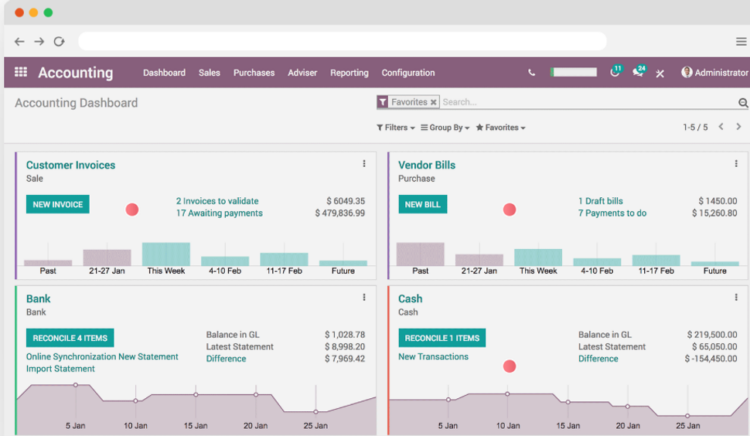What is ERP software?
Enterprise resource planning (ERP) software offers a set of tools that share a common process and data model, covering end-to-end operational processes, such as accounting, analytics, inventory management, customer relationship management (CRM), and human resources (HR) management.
Put simply, ERP software unites otherwise segregated processes into a central data network, helping businesses better track information while gathering insights from across the departmental spectrum.
Here’s what we’ll cover:
- Benefits of ERP software
- Competitive advantages of using ERP software
- Business sizes using ERP software
- Features guide
- FAQs
- Tips and tools
- Market trends to understand
- Software related to the ERP market
Benefits of ERP software
It might be a mouthful to say, but an ERP software system has plenty of benefits for businesses to chew on. Let’s discuss a few of these.
- Streamlined business operations: An ERP solution stores and tracks data across an organization, from warehouse management to benefits administration. Many ERP packages provide these functions as built-in software modules, but some also offer users the option to integrate stand-alone third-party tools, thus consolidating disparate applications into a single, unified ERP system.
- Workflow automation: By leveraging advancements in artificial intelligence (AI) technology (e.g., machine learning, natural language processing), an ERP solution can automate routine business processes and free up human capital to focus on tasks that require human intervention.
- Advanced analytics: ERP software offers greater analytical depth than other stand-alone systems, pulling a wealth of data from across your business into detailed and easy-to-decipher analytics dashboards that provide both big-picture insights and granularity.
- Enhanced accessibility: With an increasing number of cloud-based options and internet of things (IoT)-enabled functionality such as smartphone access, ERP applications offer businesses unprecedented visibility into day-to-day operations. And all that information is accessible in real time, giving users the ability to retrieve and modify data on the fly.
Competitive advantages of using ERP software
In a rapidly evolving technology landscape, businesses that utilize an ERP software solution to streamline operations will reap benefits such as:
- Increased operational efficiency: Through process automation and lean workflow management, an ERP platform can significantly boost operational efficiency and productivity.
- Better data management: Data mismanagement and disorganization can stagnate a business, preventing it from reaching its full potential. But with ERP software, individuals across a business can find the information they need in a single system, rather than juggling multiple tools and risking duplicate or inaccurate data.
- Informed business decisions: With advanced analytics comes deeper insights, giving decision-makers greater breadth of detail and a better understanding of business initiatives. The reporting capabilities of ERP software empower leaders to make more informed decisions and better position their business for success.
Business sizes using ERP software
Because of the costs and resources necessary to implement on-premise systems, ERP software has been traditionally associated with large enterprise businesses. But with the increasing availability of cloud computing solutions and Software-as-a-Service (SaaS) ERP subscription models, the typical buyer profile has expanded to include the following:
- Small-business buyers: These are companies with two to 100 employees that make less than $50 million per year and have no IT department.
- Midsize-business buyers: These companies also have two to 100 employees and make less than $50 million a year, but they have an IT department.
- Enterprise-business buyers: These are large companies that have more than 100 employees, make over $50 million a year and have a dedicated IT department.
Features guide
Common features of ERP software
To adequately compare ERP software solutions, it’s important to understand the functionality each vendor has to offer. Here are the most common features found in ERP software systems:
Accounting Manages financial transactions with general ledger, accounts receivable, accounts payable, and payroll functionality. Business intelligence Uses analytics to analyze and report business data and help companies make smarter business decisions. CRM Tracks interactions with prospects, customers, clients, and/or partners across departments. HR management Manages traditional HR activities, such as personnel tracking, benefits administration, talent management, and employee training. Inventory management Helps companies track up-to-date information about their product supply and maintain optimum stock levels. Supply chain management Monitors goods as they move from manufacturing facilities through distribution centers to retail stores.
Feature details and examples
Accounting: Accounting is one of the most basic yet the most developed functions of ERP software. It helps businesses manage and automate core accounting operations, including payroll, fixed asset tracking, and other financial management processes. Because ERP software consolidates disparate business processes, users can analyze financial data from across their organization in a single system.
 Accounting dashboard in Odoo (Source)
Accounting dashboard in Odoo (Source)
Business intelligence: To assess business performance, companies need detailed and insightful analytics data, and ERP software provides exactly that. ERP software’s business intelligence functionality includes customizable dashboards that illustrate operational data from across an organization, giving leaders the insights they need to analyze performance and make informed business decisions.
Business intelligence dashboard in Sage Intacct (Source)
CRM: The CRM module manages customer data, ranging from client information and prospective leads to help desk resources and live chat interactions. It not only gives businesses a more comprehensive and accurate view of their customer data but also allows for the automation of client-related activities, such as order processing, so you can anticipate their needs before they even contact you.
 Sales pipeline forecast in SAP S/4HANA (Source)
Sales pipeline forecast in SAP S/4HANA (Source)
HR management: ERP software broadens the scope of HR management by automating core HR functions, such as timesheet management and benefits administration. With employee data and advanced reporting capabilities at its disposal, it also aids in more strategic initiatives such as employee evaluation and recruitment.
 Employee details management in ePROMIS (Source)
Employee details management in ePROMIS (Source)
Inventory management: With features such as AI-assisted inventory tracking, ERP software helps businesses maintain optimum supply levels while avoiding overstock and product outages. ERP software’s predictive analytics capability can anticipate any spikes or dips in demand, and if inventory levels get low, the software can send out alerts and even automate replenishment.
 Inventory management in ERPAG (Source)
Inventory management in ERPAG (Source)
Supply chain management: The supply chain management module in ERP software helps streamline supply chain processes, from procurement through production to distribution. It includes functionality such as demand tracking, cost optimization, and delivery efficiency, with assistance from ERP software’s real-time inventory monitoring capabilities and process automation.
 Purchase order entry in Microsoft Dynamics GP (Source)
Purchase order entry in Microsoft Dynamics GP (Source)
ERP buyers’ top-requested features
Among the buyers we’ve spoken to, the most sought-after features are pretty evenly distributed. Financial accounting functionality is the outlier, with 84% of buyers desiring this particular feature.

Pricing guide
For an accurate snapshot of what ERP software costs, download our Pricing Guide.
FAQs
What are the key functions of ERP software?
As discussed in the “Benefits of ERP Software” section above, ERP software provides several key functions for your business, including:
- Streamlined operations: Store and track data from across the organization—including third-party integrations—to consolidate and streamline business functions.
- Workflow automation: Automate routine processes and free up human capital with AI and machine learning. Order management, inventory control, financial management, human resource functions, and sometimes even basic project management tools can be automated.
- Advanced analytics: Get big-picture insights and gauge the success of business initiatives with detailed reporting and analytics dashboards.
- Enhanced accessibility: Utilize IoT-enhanced platforms, such as cloud-based software and mobile apps, for better visibility into daily operations.
What should I ask vendors when evaluating ERP software?
Getting hands-on experience through product demos, while important, is not sufficient to evaluate ERP software options. You need to ensure that your preferred ERP software not only streamlines operations but also addresses business concerns. Engage with the vendor’s sales representative and ask some tough questions, such as:
- How does the system architecture leverage emerging technologies?
The ERP landscape is evolving at a pace we’ve never seen, with new technologies such as AI and third-party integrations becoming near ubiquitous. An ERP software system’s longevity—and your investment—therefore depends on whether these technologies are baked into the underlying system architecture, rather than tacked on after the fact.
- How much will it cost to secure and maintain access to desired capabilities?
If you’re handing over the funds for an ERP software solution, you probably want to know how your money is being spent. Ask your vendor to detail all of the initial costs (e.g., procurement and implementation), ongoing expenses (e.g., support and subscription fees), and avoided costs (e.g., ditching your old CRM software).
- What services are available to support implementation and deployment?
ERP implementation is often long and laborious, which is why many vendors offer services to guide you through the process. Businesses with limited or no IT expertise should inquire about such services and evaluate the vendor’s response time and attentiveness before signing on the dotted line.
- What long-term strategies are in place to improve your products and services?
Buying a new ERP solution is a long-term investment and should support your business needs for at least three to five years (likely more). To get the most out of your purchase, ask vendors what their product will look like one year, five years, or even 10 years down the road to gauge its future viability.
What is postmodern ERP?
As software integrations became more prevalent, a new “postmodern” breed of ERP systems emerged. In short, the term refers to the selective adoption of stand-alone software integrations to form a unified system rather than the adoption of a single, monolithic piece of ERP software. For deeper analysis, read our article “Postmodern ERP: What It Is and Why It’s Important.”
What’s the difference between on-premise and cloud ERP software?
Traditionally, ERP systems were hosted on and deployed via on-premise servers. But today, nearly every ERP vendor offers some form of cloud-based deployment, or SaaS. A cloud ERP system is hosted on the vendor’s server and accessible through a web browser or mobile app. Read about the advantages and disadvantages of each in our article “Cloud ERP vs. On-Premise ERP.”
What are some drawbacks I should watch out for?
Successful implementation of an ERP software solution requires significant capital and exhaustive preparation. Without them, implementation failure and damaging financial losses are likely. Here is an analysis of 22 failed implementation projects to help you avoid a similar fate.
Given this degree of difficulty, ERP software isn’t a viable solution for every business—especially small businesses that lack the necessary resources. But the barriers to entry are lower than they’ve ever been, with lower upfront costs and more industry-specific offerings. If you’re on the fence, check out our article “When Does a Company Need an ERP?” for a list of telltale signs that it’d be a worthy and wise investment.
Tips and tools
To equip yourself with the ERP knowledge you need, give the following articles a read:
Relevant articles
- “Dinner Is Conserved: 4 Ways ERP Software Helps Reduce Food Waste”
- “Why ERP Dashboards Are Critical to the Success of Your Business”
- “How New ERP Technologies Are Impacting Small Manufacturers”
- “Hackers Are Targeting Your ERP Security—Here’s What You Can Do About It”
Popular ERP system comparisons
- “Enterprise Resource Planning Feature Comparison, by Vendor”
- “NetSuite Competitors: Top-Recommended NetSuite Alternatives for ERP”
- “SAP Competitors: Top-Recommended SAP Alternatives for ERP”
Market trends to understand
Here are few trends in the ERP software market that you should be aware of:
- Adoption of cloud-based ERP software on the rise among SMBs: Though businesses of all sizes use cloud-based ERP software, its adoption among small and midsize businesses (SMBs) is increasing. This rise in adoption can be attributed to the various cost benefits offered by cloud-based ERP, such as ease of access, flexibility to scale operations, lower upfront investment, and elimination of maintenance hassles.
- ERP vendors to offer industry-specific customized systems: There’s a growing demand for ERP software systems tailored to meet the requirements of specific industries. In line with this demand trend, ERP vendors are expected to offer more-personalized ERP systems for each industry.
- Growing use of mobile ERP: With organizations increasingly allowing their employees to access company resources on mobile devices, many ERP vendors are upgrading their solutions to offer mobile functionality. Mobile ERP helps users access company data and perform business operations, both back end and front end, from any location while on the move.
Software related to the ERP market
Several software categories are related to ERP, whether as a subset of the software or a stand-alone system that focuses on a core component. They include:
- Cloud-based ERP system: Allows large businesses to manage and track resources and information across various departments and segments with tools delivered through cloud-based deployment, including business intelligence, inventory management, CRM, and HR.
- Inventory management software: Offers features such as product categorization, sales and purchase order tracking, electronic scanning, and automatic ordering to help businesses track their product inventories through various stages of the supply chain process.
- Manufacturing software: Provides functionality to plan and execute manufacturing projects from beginning to end by automating materials planning, production tracking and scheduling, and product lifecycle management, among others.
- Supply chain management software: Manages the entire spectrum of supply chain activities, from sourcing to distribution. It enables the automation of time-consuming processes, such as procurement and warehouse picking, and enables a data-driven approach to supply chain management.
- HR software: Helps business owners, recruiters, and HR departments attract, hire, manage, and develop employees. Applications such as payroll and attendance management can streamline operational needs, while performance and learning management can optimize worker engagement and productivity.








